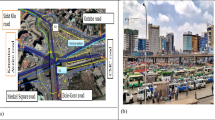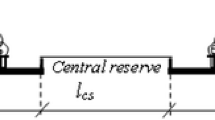Abstract
This paper describes an in-depth analysis to investigate the huge variation in the measured roadside air-pollutant concentrations of carbon monoxide and nitrogen dioxide in terms of the traffic flow levels, the orientation of the street to the prevailing wind, the wind speed, temperature and barometric pressure. The work has attempted to develop generic parameters that can be applied to other urban areas. However, in the absence of a measure of congestion at the site in Palermo (Italy), the methodological approach proposed used the simultaneous noise measurements, in units of decibels (B), to help parameterise a generic congestion indicator in terms of the traffic flow. The potential transferability of the approach was demonstrated for a site in Marylebone Road, London (UK), given the similarity of the two study sites, canyon shape, traffic characteristics and road orientation. The results showed that, within the range of data available, noise levels could be used as a proxy for flow change on the shoulders of the peak hour and hence congestion and a generic relationship with factors statistically significant at 99 % confidence allows roadside concentrations due to traffic to be estimated with a regression coefficient of R 2 = 0.73 (R = 0.85). The research demonstrates that whilst there are indeed underlying relationships that can explain the roadside concentrations based on traffic and meteorological conditions, evidence is presented that confirms the complexity of the physical and chemical processes that govern roadside concentrations.













Similar content being viewed by others
References
Agirre-Basurko E, Ibarra-Berastegi G, Madariaga I (2006) Regression and multilayer perceptron-based models to forecast hourly O3 and NO2 levels in the Bilbao area. Environ Model Softw 21(4):430–446
Allen J (2002) Chemistry in the sunlight. Earth Observatory NASA
Arnold SJ, ApSimon H, Barlow J, Belcher S, Bell M et al (2004) Introduction to the DAPPLE air pollution project. The Science of the Total Environment 332:139–153
Assael MJ, Delaki M, Kakosimos KE (2008) Applying the OSPM model to the calculation of PM10 concentration levels in the historical centre of the city of Thessaloniki. Atmos Environ 42(1):65–77
Barth M et al (1999) Estimating Emissions and Fuel Consumption for Different Levels of Freeway Congestion. Transportation Research Record: Journal of the Transportation Research Board, Vol. 1664/1999: pp. 147–57. Available from http://www.cert.ucr.edu/cmem/docs/TRR1999-Different-Congestion.pdf
Bell MC, Galatioto F (2013) Novel wireless pervasive sensor network to improve the understanding of noise in street canyons. Appl Acoust 74(2013):169–180
Belsley DA et al (1980) Regression diagnostics: identifying influential data and sources of collinearity. Wiley, New York
Benso P (1989) CALINE4—a dispersion model for predicting air pollution concentrations near roadway. California Department of Transportation, Sacramento
Carruthers DJ, Holroyd RJ, Hunt JCR, Weng W-S, Robins AG, Apsley DD, Thompson DJ, Smith FB (1994) UK-ADMS: a new approach to modelling dispersion in the earth's atmospheric boundary layer. Journal of Wind Engineering and Industrial Aerodynamics 52:139–153
Carslaw DC, Beevers SD, Bell MC (2007) Risks of exceeding the hourly EU limit value for nitrogen dioxide resulting from increased road transport emissions of primary nitrogen dioxide. Atmos Environ 41(10):2073–2082
CRTN (1988) Calculation of road traffic noise. Department of Transport/Welsh Office
Delany ME, Harland DG, Hood RA, Scholes WE (1976) The prediction of noise levels L10 due to road traffic. J Sound Vib 48(3):305–325
DETR (Department of the Environment, Transport and the Regions) (1998a) A new deal for transport: better for everyone. The Government’s White Paper on the future of transport. The Stationary Office Ltd, London
DETR (Department of the Environment, Transport and the Regions) (1998b) Review of the UK National air quality strategy: a consultation document. The Stationary Office, London
Dorzdowicz B, Benz SJ, Sonta ASM, Scenna NJ (1997) A neural network based model for the analysis of carbon monoxide concentration in the urban area of Rosario. In: Power H, Tirabassis T, Brebbia CA (eds) Air pollution V. Computational Mechanics Inc. Southampton, Boston, pp 677–685
EC (1998) Directive of 98/69/EC of the European Parliament and of the Council of 13 October 1998 relating to measures to be taken against air pollution by emissions from motor vehicles and amending Council Directive 70/220/EEC. Official J European Comm L 350:0001–0057
EU (1996) Council Directive 96/62/EC of 27 September 1996 on ambient air quality assessment and management. Official J L 296:0055–0063
Galatioto F, Zito P, Migliore M (2009) Traffic parameters estimation to predict road side pollutant concentrations using neural networks. Environ Model Assess 14(3):365–374. doi:10.1007/s10666-007-9129-z
Ghiaus C, Allard F (2005) Natural ventilation in the urban environment: assessment and design. Earthscan, London
Grant A, Bell MC (1983) Detector monitoring for management and planning. Report to Rees Jeffreys Road Fund. School of Engineering and Applied Science, University of Durham
HARMONOISE (2006) www.harmonoise.org
Harsham KD, Bennett M (2008) A sensitivity study of the validation of three regulatory dispersion models. Am J Environ Sci 4(1):63–76
Hertel O, Berkowicz R (1989) Operational Street Pollution Model (OSPM). Evaluation of the Model on Data from St. Olavs Street in Oslo. DMU Luft-A135. National Environmental Research Institute, Roskilde, p 39
HMSO (1988) Calculation of road traffic noise. Her Majesty's Stationery Office, Welsh Office, London (Crown copyright 1988. First published 1988)
Hothersall DC, Chandler-Wilde SN (1987) Prediction of the attenuation of road traffic noise with distance. J Sound Vib 115(3):459–472
Hunt PB, Robertson DI, Bretherton RD, Winton RI (1981) SCOOT—a traffic responsive method of coordinating signals. Transport and Road Research Laboratory, Crawthorne
Jenkin M (2005) Chemistry of the urban atmosphere. Environmental Science and Technology, London
IMAGINE (2011) Final report. http://cordis.europa.eu/documents/documentlibrary/124772281EN8.zip
Kokowski P, Makarewicz R (1997) Interrupted traffic noise. J Acoust Soc Am 101(1):360–371
Kukkonen J, Valkonen E, Walden J, Koskentalo T, Karppinen A, Berkowicz R, Kartastenpää R (2000) Measurements and modelling of air pollution in a street canyon in Helsinki. Environ Monit Assess 65:371–379
Makarewicz R, Fujimoto M, Kokowski P (1999) A model of interrupted road traffic noise. Appl Acoust 57:129–137
Middleton DR (2002) Uncertainties in met pre-processing for dispersion models. ADMLC Workshop, London
Moseholm L, Silva J, Larson T (1996) Forecasting carbon monoxide concentrations near a sheltered intersection using video traffic surveillance and neural networks. Transport Res D: Transport Environ 1:15–28
North RJ, Cohen J, Wilkins S, Richards M, Hoose N, Polak JW, Bell M, Blythe P, Sharif B, Neasham J, Visalakshmi S, Galatioto F, Hill G (2009) Field Deployment of the Message System for Environmental Monitoring. Traffic Eng Contr (Tec) 50(11):484–488
Sandberg U (2003) The multi-coincidence peak around 1000 Hz in tyre/road noise spectra. Euronoise Naples 2003. Available from http://informex.info/Multi-coincidence_peak_-_EuroNoise_ppr.pdf
Sharma P, Khare M (2001) Modelling of vehicular exhausts—a review. Transport Res-D 6:179–198
Smith ME (1963) The use and misuse of the atmosphere. Brookhaven Lecture Series No. 24, Brookhaven National Laboratory
Soulhac L, Pradelle F, Perkins RJ, (2004) An evaluation of the urban dispersion models. In: 9th International Conference in Harmonization within Atmospheric dispersion modeling for regulatory purposes, Germany. pp 172–176
Steele C (2001) A critical review of some traffic noise prediction models. Appl Acoust 62(3):271–287
Taseiko OV, Mikhailuta SV, Pitt A, Lezhenin AA, Zakharov YV (2009) Air pollution dispersion within urban street canyons. Atmos Environ 43:245–252
Nelson TDC. (1990) A model to calculate traffic noise levels from complex highway cross-sections TRL Transport Road Research Laboratory Report RR245. 39 pp
Vardoulakisa S, Fisherb BEA, Pericleousa K, Gonzalez-Flesca N (2003) Modelling air quality in street canyons: a review. Atmos Environ 37:155–182
Viotti P, Liuti G, Di Genova P (2002) Atmospheric urban pollution: applications of an artificial neural network (ANN) to the city of Perugia. Ecol Model 148:27–46
UniTec (2012) www.unitec-srl.com/statico/etl_2000.htm
Zito P, Chen H, Bell MC (2008) Predicting real-time roadside CO and NO2 concentrations using neural networks. IEEE Trans Intell Transp Syst 9(3):514–522, art. no. 4584204
Acknowledgements
The authors acknowledge the financial support from the EU that enabled Fabio Galatioto to spend a period of 9 months as a Marie Curie Fellow to carry out research related to his Ph.D. under the supervision of Professor Margaret Bell. The support in kind from the City Authorities in Palermo and Transport for London for making available the necessary data for this paper is much appreciated.
Author information
Authors and Affiliations
Corresponding author
Additional information
Responsible editor: Gerhard Lammel
Rights and permissions
About this article
Cite this article
Galatioto, F., Bell, M.C. Exploring the processes governing roadside pollutant concentrations in urban street canyon. Environ Sci Pollut Res 20, 4750–4765 (2013). https://doi.org/10.1007/s11356-012-1428-5
Received:
Accepted:
Published:
Issue Date:
DOI: https://doi.org/10.1007/s11356-012-1428-5




